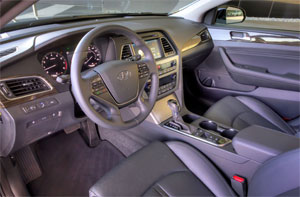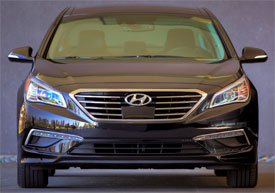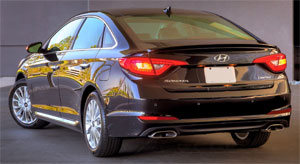2015 Hyundai Sonata
The 2011 Sonata was a watershed sedan for Hyundai. It lured buyers in with dynamic styling, and cheap prices, and kept them satisfied with great drivability and reliability. But, that was yesterday. The challenge today is to keep those buyers despite more intense mid-size competition, and to uphold their well-earned reputation. So let’s find out how an all-new 2015 Sonata measures up.
It’s difficult to fathom that the 2015 Hyundai Sonata marks the beginning of the 7th generation of the Korean middle-weight four-door. To say it has come a long way is an understatement. Evolving from a late 80’s boxy also ran, to today’s family sedan trend setter.
And it’s easy to see those trend setting ways continuing when you climb inside the latest Sonata. You’re immediately treated to a great looking interior that is incredibly comfortable and very upscale in feel. Though this Limited model’s rich 2-tone black and brown theme surely has a lot to do with that.
Not that it’s perfect. Some of our staff found the sparseness of control knobs annoying, and the few knobs that are present are either a long reach or look too similar to each other, and had some turning up the temperature when they we were trying to crank up the volume. Owners will likely figured it all out in no time, however.
 The folding rear seats offer plenty of head and leg room, and while seat cushions are a little on the hard side there is a very comfortable rake to the seat backs which makes things quite tolerable for long trips.
The folding rear seats offer plenty of head and leg room, and while seat cushions are a little on the hard side there is a very comfortable rake to the seat backs which makes things quite tolerable for long trips.
In fact, interior volume has risen enough that Sonata is now in the Large Car EPA size-class. Trunk space is certainly larger than most mid-size rivals at 16.3 cubic-ft.
An available Tech package gets you a panoramic sunroof, HID headlights, and very competent 8-inch navigation display with touchscreen. But the Ultimate package is where the tech really kicks in with smart cruise control with full stop and start capabilities, lane departure warning, forward collision warning, plus an electronic parking brake with hold feature.
As before all engines are four-cylinder and three are available. This standard, direct-injected 2.4-liter I4 rates 185-horsepower and 178 lb-ft. of torque. Peak power is actually down a little from last year in an attempt to make things more responsive. But, we found it a bit weak and noisy. A 1.6-liter turbo Eco model is new, but only recommended if fuel economy is your number-one priority. The 245-horsepower 2.0-liter turbo looks like the best choice for ample off-the line torque.
 We didn’t find that in the 2.4. Getting to 60 took us a lackluster 9.3-seconds. Well off the previous car. You do start to feel some hint of power mid-range, but slow shifts from the 6-speed automatic keep the fun factor just barely above zero. Running out the ¼-mile took 17.2-seconds at 83 miles-per-hour.
We didn’t find that in the 2.4. Getting to 60 took us a lackluster 9.3-seconds. Well off the previous car. You do start to feel some hint of power mid-range, but slow shifts from the 6-speed automatic keep the fun factor just barely above zero. Running out the ¼-mile took 17.2-seconds at 83 miles-per-hour.
Things improved somewhat through our handling course. Understeer is certainly there, but it doesn’t bombard you. Steering is quick, but the feel is artificially heavy and disconnected. Much, much better was braking performance, with solid stops from 60 that averaged just 117-feet.
This is, first and foremost, a family sedan of course, so while it’s doubtful that track performance will be high on any family’s priority list, exterior design will certainly play a much larger roll.
The fluidic sculpture 2.0 styling theme tries just as hard as the previous generation to make a statement, but we’re not sure the results are nearly as successful. Though the look, complete with LED daytime running lights and dual exhaust is now undoubtedly classier, like its better rivals. The rear appears wider and taller, with high mounted LED tail lights pointing in towards the center.
So while exterior beauty is always in the eye of the beholder, from the driver’s seat we all agree that Hyundai has certainly come a long way in chassis and suspension refinement. Ride is both solid and smooth. We also appreciated the lack of CVT transmission and found the 6-speed manual-mode automatic to work very well in daily driving.
 It proved quite efficient for a larger sedan as well, with Government Fuel Economy Ratings of 25-City, 37-Highway, and 29-Combined, which we matched almost perfectly with a 29.2 miles-per-gallon loop on Regular. The Energy Impact Score is also respectable with 11.4-barrels of oil burned annually and 5.1-tons of CO2 emitted.
It proved quite efficient for a larger sedan as well, with Government Fuel Economy Ratings of 25-City, 37-Highway, and 29-Combined, which we matched almost perfectly with a 29.2 miles-per-gallon loop on Regular. The Energy Impact Score is also respectable with 11.4-barrels of oil burned annually and 5.1-tons of CO2 emitted.
One thing that has not changed is Hyundai value with Sonata’s base pricing of just $21,960. Limited trim will cost you a fair bit more, but is still a bargain at $27,335. And of course Hyundai’s America’s Best Warranty is still in effect.
There is nothing that feels cheap about the 2015 Hyundai Sonata, particularly in upscale Limited guise, as it fully showcases the brand in their growth from low price alternative to mainstream staple. 7-generations is certainly proof that this car is more contender than pretender, and carmakers will be trying to out-do this high value nameplate for a years to come.
Specifications
- Engine: 2.4-liter
- Horsepower: 185
- Torque: 178 lb-ft.
- 0-60 mph: 9.3 seconds
- 1/4 mile: 17.2 seconds @ 83 mph
- EPA: 25 mpg city/ 37 mpg highway
- Energy Impact: 11.4 barrels of oil/yr
- CO2 Emissions: 5.1 tons/yr
2024 Polestar 2
More Range And More Power For The Polestar 2
Volvo is well on their way to making the transition to an all-electric brand, but their sister-brand Polestar is already there. Now, we’ve spent lots of time in their all-wheel drive, five-door Polestar 2, having tested it in 2021, and a year later when a two-wheel drive version arrived. But, EV updates are coming quickly. So, let us be your guide for all that’s new with the Polestar 2.
While we are driving more EVs than ever, we’ve also been spending a lot of time recently circling back to ones we’ve previously tested. As in this new era of electrified vehicles, significant updates are arriving quickly, with R&D investments increasing and retrofitting them easier than ever. This is often done through software updates that can even be accomplished over the air. For 2024, the Polestar 2 has indeed gotten some software updates, but some physical ones as well.
Clearly aimed directly at Tesla’s Model 3 when it arrived; the Polestar 2’s build quality was vastly better, but range definitely came up short. So, addressing that was priority No. 1; and for ’24 the Polestar can travel up to 20% farther than before while consuming 9% less energy, and when it comes time to charge it back up, it can do that 34% faster too.
Range in the Single Motor version increases from a max of 270 to 320 miles thanks to a larger 82-kWh battery pack, and that solitary motor now powers the rear wheels, not the front wheels. It’s also bigger, coming in at 220 kW compared to the previous 170 kW front-wheel drive version, going from 231 to 299 horsepower.
Dual Motors keep the same 78-kWh battery, but still sees a boost from 260 to 276 miles and takes advantage of the larger rear motor for a new combined 310-kW output with 421 horsepower. Our test car has the added Performance Pack, which uses an additional 35 kW to deliver 455 horsepower and 546 lb-ft of torque, though max range drops to just 247 miles.
The new battery in rear-drive 2s will also charge faster, now accepting up to 205 kW for an 80% charge in 20 minutes; max for dual-motors stays at 155 kW, which puts an 80% charge at 34 minutes. Using 32 kWh of electricity per 100 miles, the Dual Motor earns a good efficiency rating.
The [Polestar] 2 has always been one of the most enjoyable EVs to drive, even more so now with that additional power coming from the rear motor.
Unfortunately, extremely cold temperatures kept us from seeing that increased range, as we were only on pace for about 194 miles in our test.
The 2 has always been one of the most enjoyable EVs to drive, even more so now with that additional power coming from the rear motor. And especially when equipped with the Performance Pack as it not only includes more power, but adds 20-inch forged wheels, upgraded brakes, and adjustable Ohlins Dual Flow Valve performance dampers. It greatly improves handling prowess without affecting ride quality, and is easily worth the $5,500 charge if you at all enjoy driving.
Even on a 20-degree track day there was plenty of grip through our handling course. No understeer or oversteer, and lots of feedback through the wheel. There was a nice, strong launch off the line that properly planted us firmly in the seat, and rocketed us to 60 in 4.5 seconds. Power delivery stayed pretty intense up until about 80 mph when there was a definite tapering off. Still, it was a 13.4-second quarter-mile at 102 mph; smooth, quiet, and stable the whole way.
When this car debuted, its Google-based infotainment setup was a novelty, but since then, more and more manufacturers are just “Googling it” so it doesn’t seem out of place at all. The wireless phone charger is easy to access, and there’s a great Harmon/Kardon sound system and panoramic sunroof to enhance the in-cabin experience. Exteriors have also been enhanced with a smooth grille insert and new wheel choices.
Hatchback practicality means 14.3 cu-ft of easy to access cargo space with split-folding seatbacks for longer items and expanding the space to 38.7 cu-ft. Plus, there’s even a sizeable storage bin up front under the hood.
Single Motor Polestar 2 pricing now starts at $51,300, with Dual Motors starting at $56,700; topping out at $64,400.
For a car manufacturer that hasn’t even been around for a decade yet, Polestar has kept itself busy, totally transforming their latest model in just a few years, making the 2024 Polestar 2 even more appealing. They are certainly off to a good start, and with a host of Polestars just over the horizon, including some all-important utility vehicles, this star will be shining even brighter.
Specifications
As Tested
- Motor Setup: Dual Motor
- Horsepower: 455
- 0-60 mph: 4.5 seconds
- EPA Range: 247 miles
- Efficiency : 32 kWh / 100 miles
- Battery Size: 78-kWh
- Torque: 546 lb-ft
- 1/4 Mile: 13.4 seconds at 102 mph
- MW Test Loop: ~ 194 miles
- Peak Charging Rate: 155 kW











































